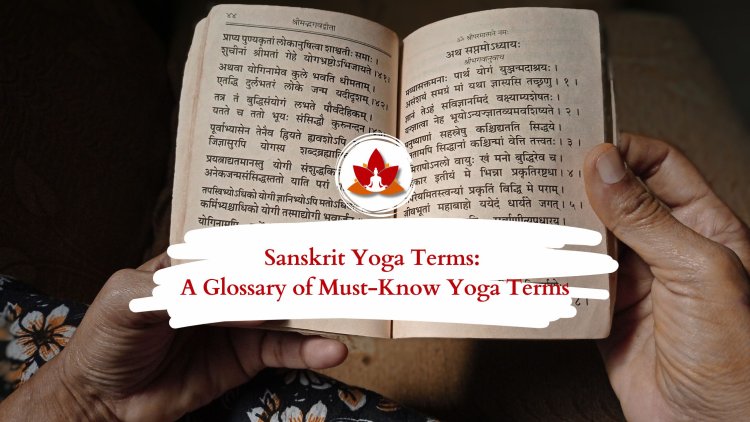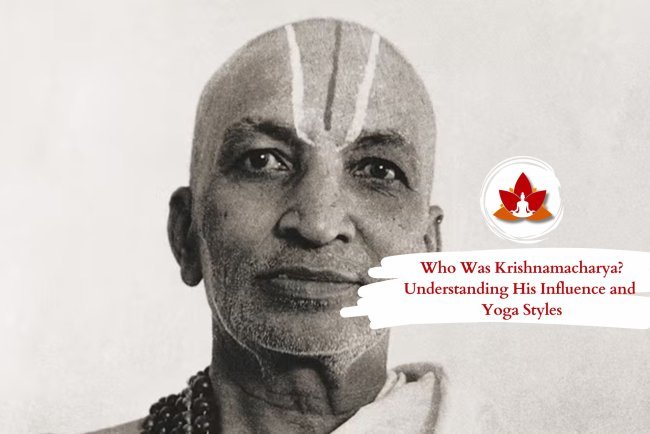Sanskrit Yoga Terms: A Glossary of Must-Know Yoga Terms

Yoga, the ancient Indian practice, is deeply bound to the sacred language of Sanskrit. It is sometimes referred to as the "mother of all languages." Its role in the heart of yoga goes far beyond its status as a linguistic treasure and a means of linking the knowledge of past times with the understanding of modern people. More than just a pursuit for scholars, an understanding of Sanskrit is opening the doors to a better understanding of your yoga practice and its profound philosophy.
A Brief History of Sanskrit: The Ancient Language of Yoga
Dating back over 3,500 years, Sanskrit is one of the oldest known languages in the world. It was the predominant form of speech of the spiritual teachings, rituals, and knowledge of ancient India. Many of the root yoga texts, such as the Yoga Sutras of Patanjali, the Bhagavad Gita, and the Upanishads, were written in Sanskrit. These writings define yoga-that is, not just the physical postures but an approach to life in its entirety.
The word "yoga" itself is derived from the Sanskrit root "yuj" or "to unite/combine." This reflects exactly the purpose of yoga, directed at harmonizing the mind, body, and spirit. What precisely makes Sanskrit strong at expressing complex philosophical concepts, mantras, and meditative practice - that is, in simple phonetic richness and powerful construction, ensuring the very essence of yoga's spirituality.
Why Study Sanskrit: Why the Meaningful Insights into Yoga Deepens
Studying Sanskrit terms is how one changes his or her yoga practice by giving meaning to every movement and concept. For example:
-
Clarity in Asanas: Many of the postures, or asanas, in yoga are named in Sanskrit, where the meaning of the name defines the essence of the posture. A student who understands these names can then be deeply aware of the symbolic purpose behind every movement.
Example: "Tadasana" ("Mountain Pose") symbolizes stability and strength, as does a mountain.
-
Honoring the tradition: Using Sanskrit in your practice, you honor the tradition and legacy of yoga.
-
Deepening of Meditation and Mantra: "Om" or Gayatri Mantra is a very sacred Sanskrit mantra with vibrational frequency to focus, calm and develop spiritual awakening. The prerequisite in Sanskrit makes it further enhance the meditative feeling connecting the individual to universal energies.
Sanskrit Words Glossary
Asana: These are the poses and postures that facilitate better flexibility, strength, and balance. Among these, the most famous ones are Downward-Facing Dog, Warrior Pose, and Tree Pose.
Ashram: This word has originated from the Sanskrit term "shrama," meaning labor. The ashram is a place where people come to stay, to meditate, and learn with a guru, or spiritual guide, for spiritual growth and discipline.
Abhyasa: Yoga practice on a continuous basis wherein consistency and discipline play the prime role, are associated with this word.
Acharya: Teacher and guide, who imparts wisdom in the yogic tradition of life.
Adwaita: Non-dualism philosophy, which states that there is only the existence of one particular unified state of consciousness or being beyond duality.
Agni: Fire in the Hindu vocabulary, which means a process of transformation and cleansing.
Agist Kriya: One of the six cleaning practices, usually known as shatkarmas and referring to inner cleanliness in the intestines.
Aham: Ego or a state of feeling of an individual self.
Ahamkara ("I-maker"): Yogis' definition of ego which is part of the mind that creates a sense of individuality or "I-ness." It also serves as an obstacle in the spiritual process because it hides higher mental faculties and causes attachment, ignorance, and alienation from the universal self.
Ahimsa: Non-violence or no injury which is the first of the five yamas in Ashtanga Yoga that promotes peace and compassion.
Ajapa Japa: Spontaneous and automatic repetition of the mantra "soham," which represents the cycle of breath of nature.
Ajna Chakra: Psychic center, or energy center, placed behind the forehead; it is one of the seven chakras, which is associated with intuition and insight.
Akasha: Ether or space; one of the five elements in yogic philosophy.
Anahata Chakra: Heart chakra or the pranic energy center that is located in the chest region, is the fourth out of the seven chakras and represents love and compassion.
Amrita: Immortality, it means deathless Spirit or eternal Atman.
Ananda: Bliss or complete joy, it is the fundamental quality of the ultimate reality.
Anga: A limb or a fundamental part of the yogic path, such as asana (posture), pranayama (breath control), or dhyana (meditation).
Antar: Inner or internal.
Antar Dhauti: Techniques of internal cleansing, which are part of the shatkarmas.
Antar Kumbhaka: Retention of breath after inhalation in pranayama, meaning inner stillness.
Antar Mouna: Inner silence, a meditative practice that is used to develop inner awareness.
Anubhava: Experience or realization, often used to describe spiritual insight.
Ardha: Half; used to describe many yogic postures (e.g., Ardha Chandrasana - Half Moon Pose).
Ashta-Anga-Yoga (Ashtanga Yoga): It comprises eight-limbed yoga as far as yama and niyama are concerned and also a set pattern of asana-posture, pranayama-breath control, pratyahara-withdrawal of sense organs, dharana - concentration, dhyana-meditation, and finally, samadhi- emergence in consciousness.
Ashwini Mudra: Anal contraction. Yogic exercise involving its practice is resorted in advanced yogas.
Atman: As a matter of fact, atma or atman would denote our Self or Spirit that always has its abode beyond time, out of physical existence.
Atma: The soul which resides in all beings.
Ayurveda: The ancient Indian system of medicine, literally "science of life," that focuses on total health and wellness.
Aum (Om): The universal sound or vibration, denoting the essence of creation and ultimate reality.
Apana (ah-pan-nah): One of the five vital winds (vayus) in Hatha Yoga and Ayurveda, Apana is the second-most important energy after Prana. It is situated on the pelvic floor and controls the outward flow of energy from the body.
Bahir: Means "outside" or "external," often used in practices or concepts involving the outward focus.
Bahiranga Trataka: Focus attention (gaze) on an external object, such as a candle flame, to enhance concentration and the clarity of mind.
Bandha ("bond/bondage"): Inner muscular locks to guide and balance energy flow through the body. This is like stability and strength.
-
Mula Bandha: Muscles of the pelvic floor.
-
Uddiyana Bandha: Muscles of the abdomen up to the diaphragm.
-
Jalandhara Bandha: Throat muscles.
Bhagavad Gita: This is a holy scripture and also one of the portions of the epic Mahabharata. It comprises the lectures provided by Lord Krishna to Arjuna during the time he experienced the war at Kurukshetra, accepting styles such as Karma Yoga-activity without egotistical self, Bhakti Yoga-worship, Jnana Yoga-wisdom, and Sannyasa Yoga-renunciation.
Bhakti: Devotion, love, or surrender towards the divine.
Bhakti Yoga: Spiritual worship through devotional life. It focuses on how love and communion with the divine can be generated.
Brahma ("he who has grown expansive"): The Creator in Hindu cosmology and the first principle (tattva) to emerge from the ultimate Reality (Brahman).
Brahman ("that which has grown expansive"): The ultimate, infinite reality that underlies all existence.
Buddha ("awakened"): That is, one who has obtained enlightenment (bodhi) and is therefore internally liberated.
Buddhi ("she who is conscious, awake"): The superior mind or intellect: seat of wisdom, discrimination, and knowledge (jnana).
Chakra: Represents the seven energy centres along the spine in the subtle body. Each affects physical, emotional, and spiritual well-being, forms the basis of the flow of energy and balance.
Chandra: The word Sanskrit for "moon," which is a metaphor for peacefulness, contemplation, and the feminine energy.
Chandra Namaskar: Also known as Moon Salutation. It is a set of yoga poses performed to invoke soothing and cooling lunar energy.
Chandra Nadi: Another term for Ida Nadi, which is a subtle channel of the left side of the body that houses the lunar energy and inner reflection.
Chidakasha: This is the psychic space that is located behind the forehead and in front of the closed eyes, typically visualized during meditation or yogic practices.
Chin Mudra: This is a symbolic hand gesture or mudra where the tip of the thumb and index finger touch to form a circle, while the other three fingers are stretched. It is used during meditation to concentrate and energize the flow of energy.
Danda: The Sanskrit word danda, meaning "stick," can denote support or discipline.
Danda Dhauti: Danda Dhauti is the shatkarma for the cleaning of the esophagus through a stick.
Danta Dhauti: "Cleaning of the teeth, yogic tradition concerned with oral hygiene."
Dharana ("holding"): Focus for concentration. It belongs to the sixth limb that the eight-limbed path of yoga of Patanjali has defined, used by focusing attention on any particular object or thought; holding the mind steady.
Dharma: Duty-righteousness-the moral pathway: often the purpose assigned by an individual in life that finds the universal law.
Dhauti: It is the second of the shatkarmas that involves rinsing with eyes, ears, tongue, forehead, esophagus, stomach, rectum, and anus.
Dhyana, "ideating": The seventh limb of Patanjali's eight-limbed yoga pertains to concentrated thought or meditation with which one becomes merged with the ultimate reality.
Diksha: It refers to the spiritual initiation or transmission of knowledge bestowed upon a disciple by his guru.
Drishti, "view/sight": A focusing point for yogic gazing, such as the space between the eyebrows or the tip of the nose, in order to better concentrate on meditation or asana practice.
Dosha: The three energies or substances of the body, according to Ayurveda, which determine one's health on both the physical and mental levels:
-
Kapha: Earth and water elements, which govern stability.
-
Pitta: Fire and water elements, which govern metabolism.
-
Vata: Air and ether elements, which control motion.
Dugdha Neti: Shatkarma to purify through a milk-based nasal cleansing.
Duhkha ("bad axle space"): Pain is one of the ideas in yoga philosophy emerging from ignorance (avidya) concerning the real nature of a person and alienation from the self.
Durga: The goddess of strength, power, and victory over evil; she stands for protection and is an important element of feminine power in Hindu mythology. She is a fearful mother to the universe and always rides a lion or a tiger to protect order and righteousness.
Dhanyavādaḥ: It is a word in the Sanskrit language that means "thank you" or "gratitude." It can be expressed in a proper respectful voice, not just in a common or casual voice.
Ghrita Neti: Nasal cleansing technique (neti) using ghee, which is clarified butter used for lubricating and cleaning nasal passage.
Cow Protector: This is one of the revered masters that is traditionally credited as the founder of Hatha Yoga. Goraksha is also linked with the Nath tradition of yoga.
Granthi (knot): Energetic blockages or knots in the central channel that can obstruct the rising of the kundalini-shakti, the serpent power
Brahma Granthi: Associated with the earthly attachments within the Muladhara of the root chakra.
Vishnu Granthi: It is related with bondage of emotions at the location of Anahata, Heart chakra.
Rudra Granthi: This granthi appears at the Ajna-the brow chakra and its relation with mental and spiritual restraint.
Guna: There are three basic attributes of the nature-Prakriti affecting behaviour and creation:
-
Tamas: Inaction, darkness, or stagnation
-
Rajas: Activity, energy, passion
-
Sattwa: Harmony, light, or purification.
Guru: A holy spiritual teacher or guide in Hinduism and yoga practices. Gurus teach, guide one on their spiritual path, and evoke a change in one's life.
Mantra: It is a sacred word, phrase, or syllable which can be chanted during meditation or as an accompaniment to focus the mind and heighten spiritual awareness. These include "Om" and mantras that give affirmative thoughts.
Yoga: In Sanskrit, the word means "join" or "unite." Yoga represents the union of the individual consciousness, that is the Atman, with the Universal Consciousness of Param Atman, attaining spiritual enlightenment and harmony.
Yogi / Siddha: one who has united, realizing the state to be fully spiritual and realizing the essence of self.
Yogini: A term strictly used to address a female in the state of union; reflection of balance, grace, and mastery in the spirit.
Swami: Title to one who has acquired self-mastery over body and mind as he is characterized with self-control and wisdom.
Beeja Mantra: Seed Syllables or "seed words" have no literal meaning but emit high vibrations; they are powerful mantras that have the ability to work on the mental and pranic (energy) bodies.
Japa: The repetition of mantras done by a person during the performance of meditation to quiet down his mind and open spiritual realization.
Guru: "Dispeller of darkness," which means a teacher providing his disciples with enlightenment and knowledge.
Omkar: Universal sound sometimes called mantra. It is the epitome of the vibration created or rather the essence behind this world.
Yoga Nidra: Sometimes called "yogic sleep," it is the art of deep relaxation at one and the same time that is an art of bridging consciousness and subconscious states.
Sadhaka: Dedicated disciple, practitioner, or seeker of yoga who dedicates himself or herself for spiritual growth and self-realization.
Paramatma: The universal consciousness representing the divine connectivity with all existence.
Shiva: That is pure consciousness, yet on the other hand he is the Lord Shiva, Lord of the universe, cosmical destroyer of ignorance.
Shakti: The very expression of pure energy has been personified in the guise of the Goddess that reflects the dynamic energy of the universe.
Hamsa (\"swan/gander\"): The word which has a symbolic sense in yoga, referring to breath or prana that is inside the body, also it refers to consciousness (jiva) who moves forward with the flow of rhythm of breath, mostly identified with self-realization and "So-Ham" (I am That) mantra.
Hatha Yoga ("Forceful Yoga"): A traditional style of yoga that was developed in the vicinity of 1000 C.E. by Goraksha and others, using such techniques as: Physical and Energy Transformation Techniques. It includes:
-
Postures: Asana.
-
Cleansing Techniques : Shodhana.
-
Breath control: Pranayama.
Hatha yoga is a gateway to other, more elevated spiritual practices using the human body and also the mind by bringing both into harmony.
Hatha-Yoga-Pradipika ("Light on Hatha Yoga"): A classic text on Hatha Yoga, composed by Svatmarama Yogendra in the 14th century. The book is one of the significant references for practice, philosophy, and objectives of Hatha Yoga apart from other basic texts, such as Gheranda Samhita and Shiva Samhita.
Jnana ("knowledge/wisdom"): Knowledge which may be classified broadly into two categories:
-
Laukika Jnana ("Worldly Knowledge"): Practical or intellectual knowledge acquired either through study or through practice.
-
World-Oriented Wisdom: Spiritual awakening or enlightenment that frees from moksha and awareness, which was basically the practice of Jnana Yoga, the path of knowledge.
Kaivalya, "isolation": The last step of moksha, total liberation from bondage of conditioned existence, according to Ashta-Anga-Yoga. In advaita tradition, the terms are synonymous; both are used interchangeably with the word for moksha or mukti which implies the release from ignorance and bondage of cycles of birth.
Karman, Karma ("action"): Actions, both ritual acts and their resultants. This includes:
-
Action: The physical, mental, or spiritual acts of action.
-
Karmic Fruit: Cause and effect whereby an act leads to consequences for the future.
-
Fate: Determined by accumulated karmic amasses.
Karuna: Compassion. Sympathy in everything; feeling intense sorrow of others. In Buddhism yoga, karuna is an amalgamation with prajna to acquire an equilibrious way toward enlightenment.
Kundalini-Shakti ("coiled power"): A spiritual energy that exists in potential form at the base of the spine, in the Muladhara Chakra. According to Tantra and Hatha Yoga, enlightenment is achieved by awakening this serpent power and guiding it through the chakras to the Sahasrara Chakra at the crown of the head.
Nadi (channel): Fine canals of the body,around 72,000 in number,where the life force (prana) passes. There are three main nadis:
-
Ida Nadi: Lunar energy and left side of the body
-
Pingala Nadi: Solar energy and right side of the body
-
Sushumna Nadi: The middle canal through which kundalini-shakti moves upward
Namaste ("I bow to the divine in you"): A respectful Hindu greeting performed with a slight bow and hands pressed together in Anjali Mudra at the heart center, acknowledging the divine spark within each being.
Niyama ("[self-]restraint"): The second limb of Patanjali’s Eightfold Path (Ashta-Anga-Yoga), focusing on personal discipline and consisting of five practices:
-
Saucha: Purity or cleanliness.
-
Samtosha: Contentment.
-
Tapas: Austerity or self-discipline.
-
Svadhyaya: Self-study or study of scriptures.
-
Ishvara-Pranidhana: Dedication or surrender to a higher power.
Nyasa ("placing"): A Tantric practice of channeling and infusing life force (prana) into specific body parts by touching or visualizing the corresponding area, enhancing spiritual focus and energy flow.
Samadhi ("putting together"): The ultimate meditative state where the practitioner becomes one with the object of meditation. It is the eighth and final limb of Patanjali’s Eightfold Path. Types of Samadhi include:
-
Samprajnata (conscious ecstasy): Consciousness is there
-
Asamprajnata (supra conscious ecstasy): Transcends consciousness and breaks the bondage of karmas.
Superior to these is Sahaja-Samadhi or the state of spontaneous or natural enlightenment wherein superconsciousness pervades the states of wakeful, dream, and slumbering consciousness
Samsara ("confluence"): The relative, bounded world of coming-to-be and existence which stands in relation to the absolute, timeless, and immutable ultimate reality (Brahman or Nirvana).
Satya ("truth/truthfulness"): Represents both ultimate reality and the practice of truthfulness, a fundamental aspect of Yama (moral discipline) in Patanjali’s path.
Shakti ("power"): The feminine manifestation of ultimate reality and the dynamic power of the divine. In yoga, Shakti represents energy and creation, complementing Shiva's consciousness.
Shiva ("He who is benign"): A central deity and archetype for yogis, representing pure consciousness and the destroyer of ignorance in Hindu cosmology.
Shodhana ("cleansing/purification"): A core principle in all yogic traditions, involving physical, mental, and energetic purification. In Hatha Yoga, this includes specific techniques under the shatkarmas.
Sutra ("thread"): A concise aphorism or verse, often serving as a teaching or guideline. Examples include Patanjali’s Yoga Sutra, foundational to yoga philosophy.
Yama ("restraint/self-control"): The first limb of Patanjali’s Eightfold Path, focusing on moral discipline. It consists of five practices:
-
Ahimsa: Non-violence.
-
Satya: Truthfulness.
-
Asteya: Non-stealing.
-
Brahmacharya: Moderation.
-
Aparigraha: Non-possessiveness.
What's Your Reaction?


























